“This highly recommended tribute to the imagination is comprised of delightful pictures and three clever and entertaining stories.” –Booklist, starred review
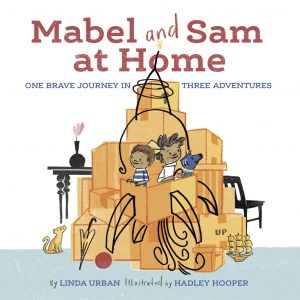
There’s a beautiful new picture book in the world today, and it’s a perfect choice for kids with big imaginations. MABEL AND SAM AT HOME is written by my friend Linda Urban and published by Chronicle Kids. Here’s the official description…
At the new house, there were movers and shouting and boxes and blankets. There were many places a girl like Mabel and a boy like Sam could be tripped over or smooshed or trod upon. There was one safe place where they would not. And that is how Mabel became a Sea Captain. In this three-part picture book of moving house and imaginative play, Mabel and Sam sail the high seas of their new home; tour the intriguing museum of their living room; journey through outer space to the safety of their own beds; and discover how far afield—and how close to home—imagination can take them.
Linda and I are good friends who constantly talk writing – over lattes in Burlington, VT or chatting online. We thought it might be fun to invite everyone else into one of those conversations as we celebrate Linda’s new book. So get yourself a cup of coffee or tea or whatever you love, and listen in….
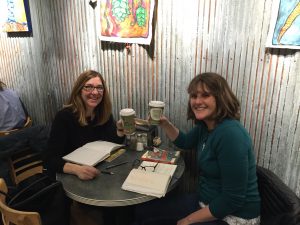
KATE: Hi, Linda! You already know this, but I’m SO excited about your new picture book MABEL AND SAM AT HOME releasing today, especially because I was there to hear some of your early noodling on this project. This is a picture book, but I think in those earlier days, you were thinking of it as more of an easy reader or transitional chapter book, right?
LINDA: Right. You know I have wanted to write an easy reader for a long time, but as soon as Mabel and Sam started talking it was pretty clear that their vocabulary would be too complicated for very beginning readers. A transitional reader seemed more reasonable and I wrote five chapters about these two imaginative kids using play to get comfortable in their new environment. A few editors who saw it mentioned that the story had a very visual quality that suggested the possibility of a picture book interpretation, but it was Melissa Manlove at Chronicle who sorted out how that might actually work. It was her idea to cut two of the stories and treat the other three as episodes/adventures in one expanded picture book.
You’ve worked with Melissa, I know. She’s got amazing vision and can see a project in ways nobody else does. I think you’re working on something for her now that might feel similar?
KATE: Yes! Melissa really does have an amazing gift when it comes to looking at a manuscript and imagining what it might be. We were having a very casual dinner in Montreal (Melissa was there for a conference) when she asked what I was working on and I told her, “Well…it’s kind of a mess right now, but I have this idea for a picture book about American presidents…” In ten minutes, she’d whipped out a pen, asked for an extra napkin, and sketched out how the project I was describing might look on the page. It’s fun knowing how she worked that same kind of magic with MABEL AND SAM AT HOME.
One of the other things I love about your new book is how you capture the dynamics between brother and sister and the real-kid language of imaginative play. How much of that came naturally, inspired by your own kids, and how much of it was the result of playing around with language as you revised?
LINDA: When my kids were little they played in very much this style — sort of like little kid improv, riffing on each other’s ideas, picking up language from one another and rolling it around to see where it led.
As a parent, I was terrible at it. I could not engage in their play in the natural, free-form, open-ended way that they did. I was fine to serve tea to or to string up blankets for safari tents, but I was not IN play in the way that they were. I was always aware of how much time there was before I needed to make dinner or checking myself on the logic of space walking without an oxygen tank. And they sensed it. I was audience or prop master, not player.
One of the great things about writing, for me, is that when I am writing well, I am experiencing the fictive world through the character, much like my kids do when they play.
For me, so much of that experiencing is in point of view as understood through dialogue. I’d love to claim some sort of careful crafting here, but really, if I’m feeling IN the character, the dialogue is of that character, too.
This is not to say that there wasn’t a lot of revision. There was. And it tended to be of two different kinds. One sort is the analytical revision, the kind that comes with the conscious mind that recognizes a scene takes too long or that an action verb would be more powerful than using a verb/adverb combination. The other sort is what Robert Olen Butler would call “redreaming” and feeling myself go back into that character world and expanding or rephrasing in a more improvisational way, just like kids do when they play. Is it the same for you, Kate?
KATE: In many ways, yes – it’s always interesting to me how when you and I are teaching together at a workshop, I gravitate toward the big-picture revision things (like my beloved charts!) and you have such a gift for the fine tuning of words and sentences and language. And I know that your notebooks play a big role in your thinking process, too, whether it comes to brainstorming or revision. Can you talk a little about that – how writing about the manuscript but not in the manuscript is helpful? (And could we maybe see a page or two? Pretty please?)
LINDA: I’ll see if I have a notebook page for Mabel and Sam around, but I can tell you that the notebook part of my thinking is most valuable to me because it is in the notebook and not typed up in the same sort of format that my manuscripts are.
When I first started writing, it was all play. While I dreamed of publication, I wasn’t writing with anything under contract or expecting that THIS would be the book that sold. It was all loosey-goosey messing around and mostly just for me. Once I sold something, a little bit of that play slipped away. I started thinking that the writing needed to “count”, you know?
When I started writing by hand in a notebook, though, a lot of the play came back. Of course what I was writing wasn’t for anyone else to see! It was in handwriting and messy and it looked and felt nothing like the sort of thing I’d submit to an editor.
I’m a big fan of Lynda Barry and I believe a lot of what she says about how the hand being in motion can sometimes let us access thoughts and memories and modes of play that typing doesn’t — at least, I believe that’s true for me. So I mess around a lot in my notebooks in order to experience things differently, to come at them from new angles, or to get outside of my own awareness.
I’ll go look for a notebook example now.
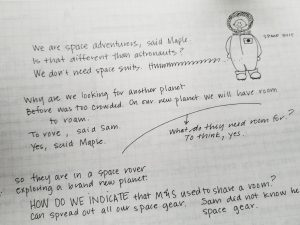
I know you carry a notebook with you everywhere, too. But I think you also have project notebooks, right? How are they different and when do you find you use them most?
KATE: I do! It’s important to me to get away from the manuscript. It’s like I can’t talk about it while it’s right there in my face, so writing elsewhere helps a lot. But these scribblings are not as pretty, so I have a major notebook crush on yours. I especially love seeing how they help you move forward with a story.
Hey – can we talk about the art in this book for a minute? Because as you know, I read this manuscript long before there was even an artist on board, and I truly cannot imagine it in the hands of anyone except Hadley now. It’s brilliant.
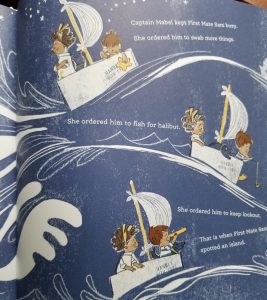
LINDA: IT IS! Completely, beautifully, stunningly brilliant. I love the way she characterized these two kids. I love the way she grows and broadens the color palette as the grow more and more comfortable in their home. I love the way household objects take on metaphorical value and then return to themselves again.
I think her work in Iridescence of Birds and Another Way to Climb a Tree is wonderful, but she has outdone herself here.
There’s such a growing sense of warmth and comfort as the book comes to a close, too. I want to live in that room, with that family, under that moon.
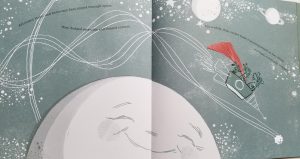
KATE: Me too! And that’s a perfect note for us to end on for now, I think.
Linda, thanks for doing this with me, and congratulations to you and Hadley on such a magical adventure of a story!
Everybody else….you should go read it now. Seriously. Read it to a kid if you can. And then imagine an adventure of your own.




